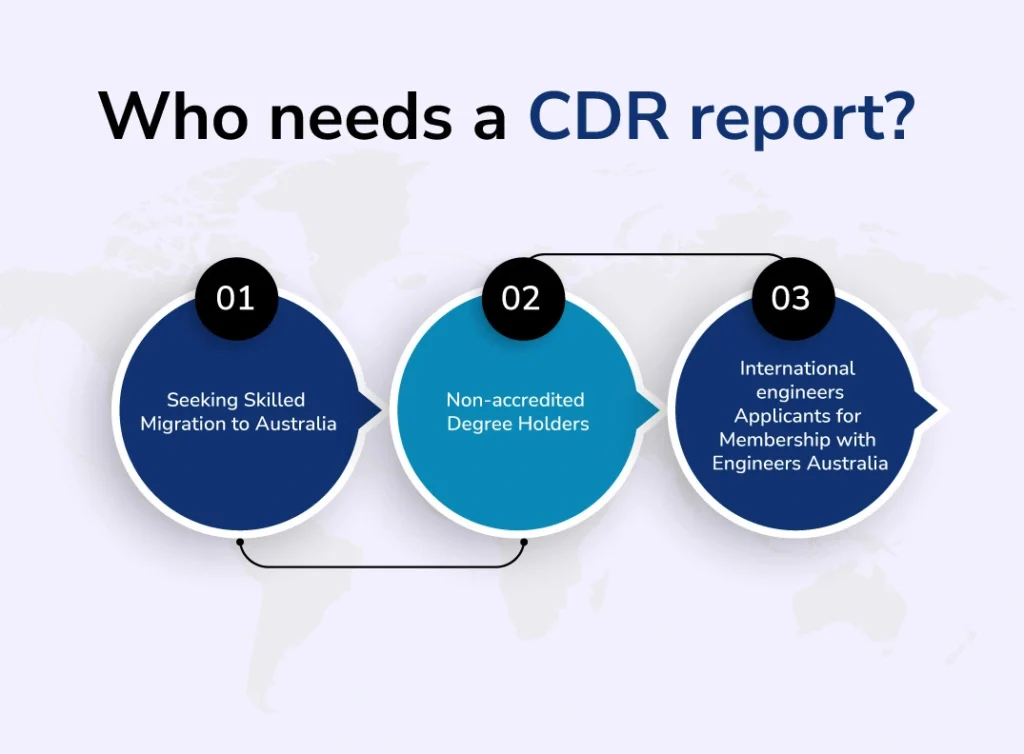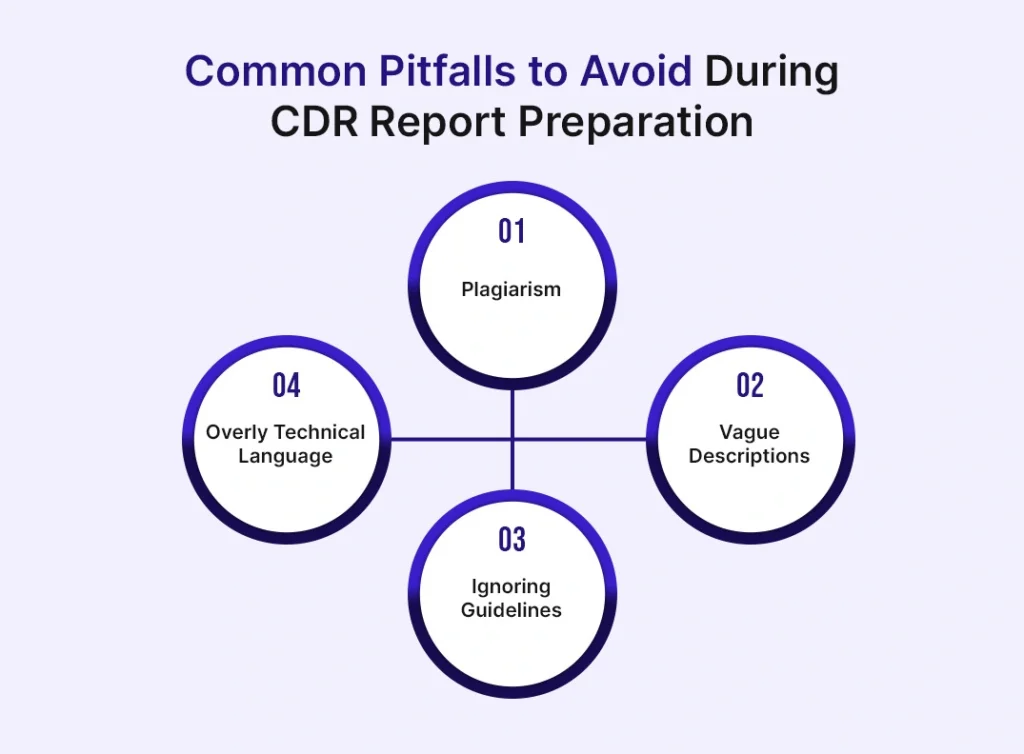
In today’s globalized world, professional recognition across borders is essential for career growth and opportunities. For engineers, the Competency Demonstration Report (CDR) is a critical document facilitating this international recognition.
In the professional engineering world, achieving professional recognition across international borders is crucial for career growth and opportunities. For engineers aspiring to migrate to Australia, the Competency Demonstration Report (CDR) is an essential document for this purpose.
This comprehensive portfolio, required by Engineers Australia, evaluates the skills, knowledge, and qualifications of engineers aiming to establish their careers in Australia.
This introduction will delve into the details of what a CDR report is, who needs it, and why it is vital for engineering professionals seeking to validate their expertise and secure a future in the Australian job market.
Understanding the importance of the CDR enables engineers to better prepare for a successful assessment and a rewarding career in Australia.
What is a CDR report?
A CDR (Competency Demonstration Report) is a collection of documents required by Engineers Australia (EA) to assess the competencies and qualifications of engineers who wish to migrate to Australia.
The CDR report demonstrates that an engineer’s education and professional experience meet the standards set by Engineers Australia, which is the authority that evaluates engineering qualifications for migration purposes.
It includes a detailed CV, a Continuing Professional Development (CPD) record, three career episodes describing specific engineering projects or tasks, and a summary statement linking these episodes to the competencies defined by Engineers Australia.
The CDR report is essential for engineers from countries without mutual recognition agreements, enabling them to gain professional recognition and practice engineering in Australia.
Editor’s Choice: What is the CDR report and its importance for migration to Australia?😍❤️🔥✈️
Components of a CDR Report

A CDR is like a portfolio for engineers wanting to work in Australia. It’s made up of several important parts that, together, show off your engineering skills and experience.
A CDR report is also a comprehensive document required by Engineers Australia to evaluate the qualifications and professional experience of engineers seeking to migrate and work in Australia.
The CDR consists of several key components: personal information, including identification and a recent photograph; a detailed CV; and a record of continuing professional development (CPD) activities.
The core of the CDR is the three career episodes, which are narrative essays that describe specific engineering projects or tasks, showcasing the applicant’s problem-solving abilities and application of engineering principles.
Each career episode is complemented by a summary statement, which maps the content to Engineers Australia’s competency standards, ensuring all necessary skills and knowledge are demonstrated.
Together, these components provide a thorough and structured representation of an engineer’s qualifications, making the CDR report an essential tool for professional recognition in Australia.
A comprehensive CDR report consists of several parts, and here’s a closer look at each piece:
- Personal Information
This includes documents like your passport, academic records, and any official identification.
- Application Form
A form provided by Engineers Australia must be filled out accurately.
- Curriculum Vitae (CV)
A detailed resume outlining your professional history, educational background, and relevant skills or certifications.
- Continuing Professional Development (CPD)
A list of activities that show you are keeping up with developments in your field.
- Three Career Episodes
Detailed descriptions of three separate engineering projects or work experiences that demonstrate your competencies.
Each episode should be:
- Written in the first person.
- Focus on what you did personally.
- Demonstrating your problem-solving skills and engineering knowledge.
- Summary Statement
A summary that maps your career episodes to the competencies required by Engineers Australia.
Tips for a Winning CDR Report
- Keep it clear and consistent throughout your report. Avoid using overly technical language.
- Double-check everything for accuracy, especially dates and names.
- Make sure your work is original, and use plagiarism checkers if needed.
- Present your CDR professionally with a clear structure and format.
- Learn from CDR report samples available online for reference.
By carefully putting together each part of your CDR, you can effectively showcase your engineering skills and increase your chances of getting a positive evaluation from Engineers Australia.
Learn more: How to Write a CDR Report for EA? ❤️🔥✈️
Detailed Breakdown of Key Components
Continuing Professional Development (CPD)
The CPD list demonstrates your commitment to keeping your professional skills current. It includes activities such as:
- Workshops
- Seminars
- Training courses
- Conferences
- Technical meetings
- Self-study (reading journals, manuals, books, etc.)
Each entry should include the title of the activity, the date, the duration, and a brief description.
Career Episodes
Each career episode is a narrative that describes your engineering education and/or work experience. These episodes are crucial because they showcase your application of engineering knowledge and skills in real-world scenarios.
These are detailed stories (1,000 to 2,500 words) about specific engineering projects you’ve worked on. Write them in first person (“I”) and include:
- Introduction
Briefly state the project name, dates, location, and your role.
- Background
Explain the project goals and your involvement.
- Personal Engineering Activity
Focus on what you did, the choices you made, and how you solved problems using engineering principles.
- Summary
Reflect on the project, your achievements, and what you learned.
Learn more: Should three career episodes be completely different in a CDR? ✈️❤️🔥
Summary Statement
The summary statement is a cross-referencing tool that links specific parts of your career episodes to the competencies required by Engineers Australia. It’s essentially an overview that ensures you have addressed all the necessary competencies throughout your career.
This is where you connect your career episodes to the specific skills Engineers Australia is looking for. Here’s how to do it:
- Review the required competencies.
- Match specific paragraphs from your career episodes to these competencies.
- Clearly show where, in your work examples, you demonstrated each competency.
Who needs a CDR report?

A Competency Demonstration Report (CDR) is crucial for engineers who wish to migrate to Australia and have their qualifications recognized by Engineers Australia. The following groups specifically require a CDR report:
Engineers from Non-Accord Countries
Engineers who earned their qualifications from countries not part of the Washington Accord, Sydney Accord, or Dublin Accord need to submit a CDR.
These accords are international agreements that mutually recognize engineering education standards. Engineers from non-accredited institutions must prove their education and experience meet Australian standards.
Engineers from Accord Countries with Non-Accredited Programs
Even engineers from countries that are signatories to these accords may need to provide a CDR if their specific engineering program isn’t accredited. This ensures their competencies align with Australian requirements.
Engineers Seeking Specific Occupational Categories
Engineers aiming for recognition in particular occupational categories, such as Professional Engineers, Engineering Technologists, Engineering Associates, or Engineering Managers, must prepare a CDR if their qualifications do not automatically match Engineers Australia’s standards for those categories.
Engineers with Non-Standard Career Paths
Engineers who have followed non-traditional career paths, such as gaining significant practical experience without a standard engineering degree, may use the CDR to demonstrate their competencies and achievements instead of formal academic qualifications.
Engineers Needing Skills Assessment for Migration
The CDR is an essential part of the skills assessment for engineers applying for migration to Australia under the General Skilled Migration (GSM) program. It demonstrates their qualifications, skills, and professional experience to meet the criteria set by Engineers Australia and the Department of Home Affairs.
In summary, engineers from non-accord countries, those with non-accredited programs, those seeking recognition in specific occupational categories, those with non-standard career paths, and those needing a skills assessment for migration purposes require a CDR. It is vital for validating their qualifications and supporting their professional journey in Australia.
Countries Requiring a CDR Report
Engineers from countries like Nepal, India, Pakistan, Bangladesh, Sri Lanka, and several others, where engineering degrees are not automatically recognized by Engineers Australia.
For this reason, they are required to have their qualifications assessed by the Engineers Australia technical assessors before their applications can be considered.
The report is used to assess the applicant’s competency and suitability for the Australian engineering industry. However, engineers from countries with mutual recognition agreements, such as the USA, UK, Canada, and some European nations, may not require a CDR.
Document Checklist for Accredited Qualifications
- A recent color photograph (35mm x 45mm)
- Passport
- Academic records
- Certificates and awards of Accredited Qualifications
- Updated Resume
- Proof of name change (if applicable)
- English Language Proficiency Test results from a recognized authority
Document Checklist for Non-Accredited Qualifications
- A recent color photograph (35mm x 45mm)
- Passport
- Academic transcripts for non-accredited courses
- Description of courses and subjects studied
- Certificates and awards of Non-Accredited Qualifications
- Updated CV/Resume
- Proof of name change (if applicable)
- English Language Proficiency Test results from a recognized authority
Why is a CDR Report Important?

A Competency Demonstration Report (CDR) is crucial for engineers who want to migrate to Australia and have their skills recognized by Engineers Australia. The CDR helps ensure that an engineer’s qualifications and professional experience meet the standards required to work in Australia.
It’s an essential part of the skilled migration process, especially for those from countries without a mutual recognition agreement with Australia. By compiling a CDR, engineers provide detailed accounts of their work experiences, showcasing their technical skills and problem-solving abilities.
This document helps Engineers Australia evaluate whether the applicant’s skills align with Australian engineering standards.
Achieving this recognition can significantly boost an engineer’s career, opening up better job opportunities, higher salaries, and positions of greater responsibility.
Moreover, the CDR process encourages engineers to reflect on their professional journey, identifying their strengths and areas for improvement.
It also ensures they are familiar with Australian engineering practices and ethical standards, which is vital for maintaining safety and integrity in engineering projects.
In essence, a well-prepared CDR is not just a requirement but a valuable tool for professional growth and global competitiveness.
Here are a few reasons for the importance of the CDR Report:
1. Migration and Career Opportunities
For engineers aiming to migrate to Australia, the CDR report is a vital component of their visa application process. It validates their qualifications and professional experiences, thereby facilitating their eligibility for skilled migration visas.
2. Professional Recognition
The CDR report ensures that an engineer’s competencies meet Australian standards, thus providing a pathway to professional recognition in Australia.
This recognition is crucial for career advancement, higher salary prospects, and access to more significant job opportunities.
3. Benchmarking Skills
Creating a CDR report encourages engineers to reflect on their professional journey, highlighting their strengths and identifying areas for improvement. This self-assessment can be beneficial for personal and professional growth.
4. Global Competitiveness
By meeting the stringent requirements of Engineers Australia, engineers can position themselves as globally competitive professionals. This recognition can open doors to international career opportunities beyond Australia.
5. Compliance with Australian Standards
The CDR ensures that migrating engineers understand and comply with Australian engineering practices and ethical standards. This compliance is crucial for maintaining the integrity and safety of engineering projects in Australia.
How do you prepare an effective CDR report?
Preparing an effective Competency Demonstration Report (CDR) involves several crucial steps to ensure it meets the standards set by Engineers Australia. Start by thoroughly understanding the requirements and guidelines, then gather all necessary documents, such as academic transcripts, certificates, and an updated resume.
Each career episode should detail specific projects or work experiences, focusing on your contributions and the engineering principles applied. Use clear, concise language and avoid technical jargon to ensure readability.
Document your continuing professional development (CPD) activities to show ongoing learning in your field.
Proofread CDR reports multiple times to eliminate errors, ensure coherence, and use plagiarism detection tools to confirm originality. If needed, seek professional assistance to enhance the quality of your submission.
By meticulously following these steps, you can create a compelling CDR that effectively showcases your engineering skills and competencies.
Here are a few steps to be followed to prepare an effective CDR report for migration to Australia:
Understand the Requirements
Before you start preparing your CDR, thoroughly understand the guidelines provided by Engineers Australia. This includes understanding the competencies you need to demonstrate and how to structure your Career Episodes and Summary Statement.
Be Authentic and Precise
Your CDR should be a true reflection of your skills and experiences. Avoid exaggeration and ensure that all information is accurate and verifiable. Engineers Australia has strict plagiarism policies, so originality is key.
Focus on Competencies
Demonstrate your competencies in each career episode. Use specific examples to illustrate your problem-solving abilities, technical knowledge, and leadership skills. Make sure each episode covers different aspects of your engineering experience.
Detailed Career Episodes
When writing your career episodes, follow a clear structure
- Introduction
Describe the project and your role.
- Background
Provide context about the project, including the objectives, your role, and the organizational structure.
- Personal Engineering Activity
Focus on your contributions. Detail the tasks you performed, the challenges you faced, and how you addressed them.
- Summary
Summarize the key points of your episode, including what you learned and how it contributed to your professional development.
Effective Summary Statement
The Summary Statement should be concise yet comprehensive. Use it to map specific points in your Career Episodes to the required competencies. This cross-referencing is crucial for demonstrating that you have met all the necessary criteria.
Proofread and Edit
Ensure your CDR is free from errors. Proofread multiple times and consider having someone else review it as well. Clarity, accuracy, and professionalism are vital.
Common Pitfalls to Avoid During CDR Report Preparation

Plagiarism
One of the most serious issues in CDR preparation is plagiarism. Engineers Australia uses advanced plagiarism detection software. Ensure all your work is original, and properly reference any sources or collaborations.
Vague Descriptions
Avoid vague descriptions of your roles and responsibilities. Be specific about your contributions and the impact of your work. Highlight your problem-solving and technical skills with concrete examples.
Ignoring Guidelines
Not adhering to the guidelines provided by Engineers Australia can lead to rejection. Make sure you follow the structure, format, and content requirements meticulously.
Overly Technical Language
While technical details are essential, remember that the assessors may not be experts in your specific field. Use clear, concise language and avoid excessive jargon. Explain technical terms when necessary.
Learn more: 7 Reasons why your CDR got rejected by Engineers Australia.✨❤️🔥
The Role of Professional Help
Creating a Competency Demonstration Report (CDR) for Engineers Australia can be a daunting task, requiring meticulous detail and adherence to specific guidelines. For many engineers, seeking professional help in writing their CDR report and CDR report review can be immensely beneficial.
Here’s an in-depth look at how professional assistance can play a crucial role in this process:
Expertise in CDR Guidelines
Professional CDR writers have an in-depth knowledge of the guidelines set by Engineers Australia. They understand the specific requirements and expectations for each component of the CDR, ensuring your submission meets the precise standards needed for a successful assessment.
Tailored writing and presentation
professionals can customize your CDR to effectively highlight your unique skills and experiences. They know how to present your career episodes in a way that best showcases your competencies, aligning your professional experiences with the required standards. This personalized approach significantly enhances the clarity and impact of your CDR.
Time Efficiency
Crafting a comprehensive CDR can be time-consuming, particularly for engineers who are juggling their professional responsibilities. Professional assistance streamlines the process, allowing you to focus on your work while experts handle the complexities of your CDR. This saves valuable time and reduces stress.
Language Proficiency
Clear and precise language is essential for a successful CDR. Professional writers possess the language skills necessary to articulate their experiences and skills effectively. They eliminate grammatical errors, improve sentence structure, and ensure your report is easy to read and understand.
Originality and Plagiarism Check
Professionals are skilled at creating original content that accurately reflects your personal experiences. They use plagiarism detection tools to ensure your CDR is free of copied content, which is crucial since Engineers Australia has strict policies against plagiarism.
Comprehensive Review and Editing
A professional CDR service includes thorough review and editing processes. Experts critique your initial drafts, provide constructive feedback, and make necessary revisions. This ensures your final submission is polished and adheres to all guidelines.
Mapping Competencies Accurately
The Summary Statement requires precise mapping of your Career Episodes to the competencies outlined by Engineers Australia. Professionals are adept at identifying and linking relevant experiences to these competencies, ensuring each element is comprehensively covered.
Support and Guidance
Professional CDR writers offer ongoing support and guidance throughout the preparation process. They answer your questions, clarify doubts, and provide advice on how to best present your experiences. This support is invaluable, especially for those unfamiliar with the CDR requirements.
Higher Chances of Success
With professional help, your CDR is more likely to meet the high standards required by Engineers Australia. This increases your chances of a successful assessment, facilitating your migration and professional recognition in Australia.
Conclusion
A CDR report is an essential document for engineers seeking to migrate to Australia. It serves as a testament to their competencies, skills, and professional experiences.
Preparing an effective CDR requires a thorough understanding of the guidelines, attention to detail, and a clear demonstration of engineering abilities.
By understanding what a CDR report entails, who needs it, and why it is crucial, engineers can better navigate the process and enhance their chances of success. Whether preparing it independently or seeking professional help, the goal remains the same: to achieve recognition and open doors to exciting career opportunities in Australia.
FAQs
- What is a CDR report?
A Competency Demonstration Report (CDR) is a comprehensive document required by Engineers Australia to evaluate the skills, knowledge, and qualifications of engineers aiming to migrate to Australia. It includes personal information, a resume, Continuing Professional Development (CPD) records, three career episodes, and a summary statement.
- Who needs to submit a CDR report?
Engineers who have obtained their qualifications from countries not part of the Washington Accord, Sydney Accord, or Dublin Accord, or whose specific programs are not accredited under these accords, need to submit a CDR. Additionally, engineers with non-traditional career paths or those seeking a skills assessment for migration purposes may also need to prepare a CDR.
- Why is a CDR report important?
The CDR is crucial for proving that an engineer’s education and professional experience meet Australian standards. It is a vital part of the skills assessment process required for professional recognition by Engineers Australia and for migration to Australia under the General Skilled Migration (GSM) program.
- What are the key components of a CDR report?
A CDR report comprises personal information, a detailed CV, CPD records, three career episodes that describe specific engineering projects or tasks, and a summary statement that maps the career episodes to Engineers Australia’s competency standards.
- How do career episodes in a CDR report work?
Career episodes are narrative essays in which engineers describe specific engineering projects or tasks they have undertaken. Each career episode should include an introduction, background, a detailed description of personal engineering activity, and a summary. They are designed to showcase the engineer’s competencies and problem-solving skills.
- What is the purpose of the summary statement in a CDR report?
The summary statement connects the competencies outlined by Engineers Australia to specific paragraphs in the career episodes. This mapping ensures that each competency element is demonstrated within the narrative of the career episodes.
- Can a professional help improve my CDR report?
Yes, professional CDR writers can offer expertise in Engineers Australia’s guidelines, customize the report to highlight unique skills and experiences, ensure clear and precise language, check for originality and plagiarism, and provide comprehensive review and editing services to enhance the quality of the submission.
- What is the role of continuing professional development (CPD) in a CDR report?
The CPD section shows an engineer’s commitment to ongoing learning and professional growth. It includes activities such as workshops, seminars, training courses, conferences, and self-study, providing evidence of continued professional development.
- How does Engineers Australia assess a CDR report?
Engineers Australia evaluates a CDR report by reviewing the detailed descriptions of the engineer’s education and work experiences to ensure they meet Australian standards. They look for evidence of the application of engineering knowledge and problem-solving skills as outlined in the competency standards.
- What happens if my CDR report does not meet Engineers Australia’s standards?
If a CDR report does not meet the required standards, Engineers Australia may request additional information or clarifications. In some cases, the application may be rejected, and the engineer may need to revise and resubmit their CDR with the necessary improvements.

